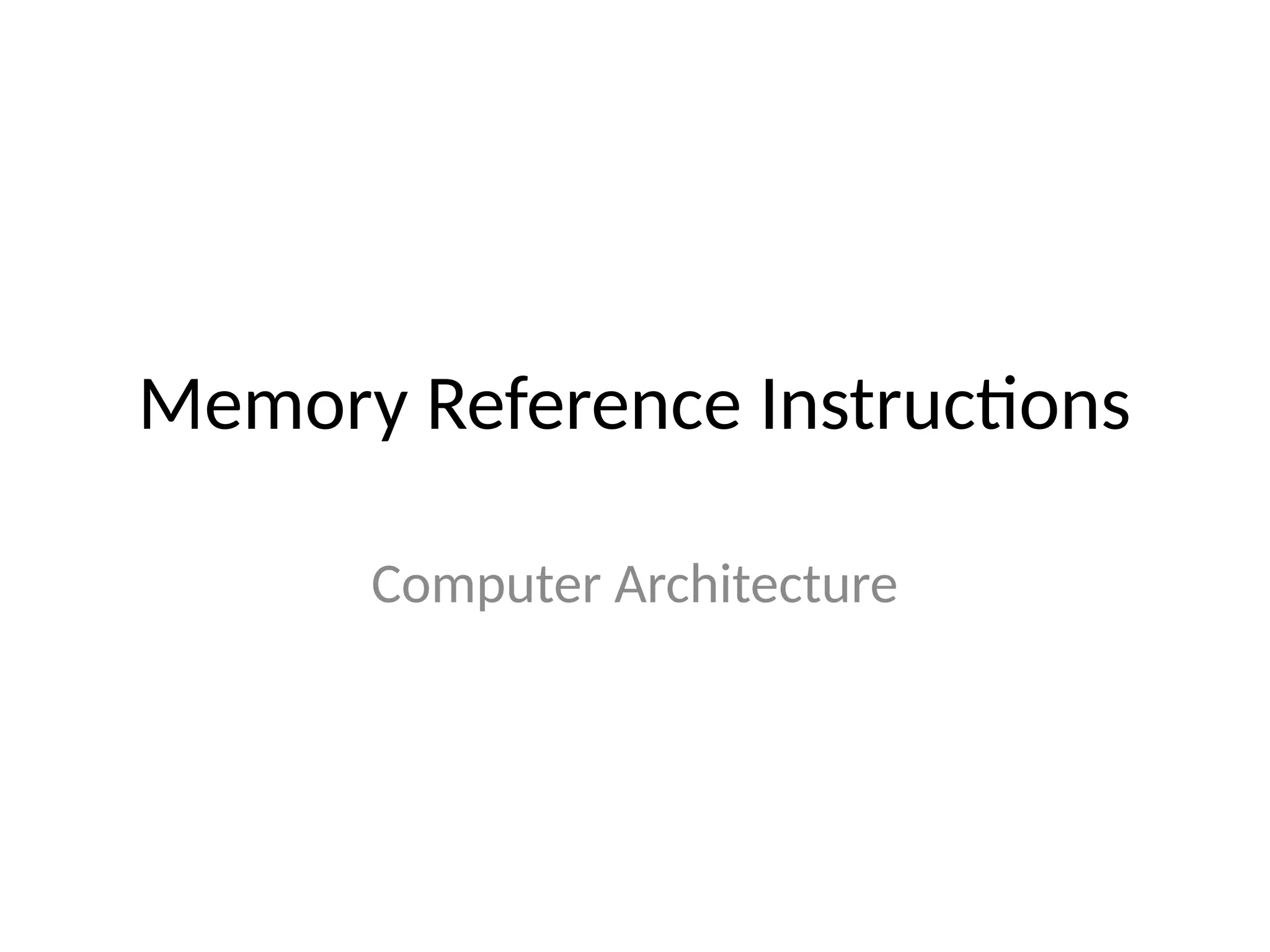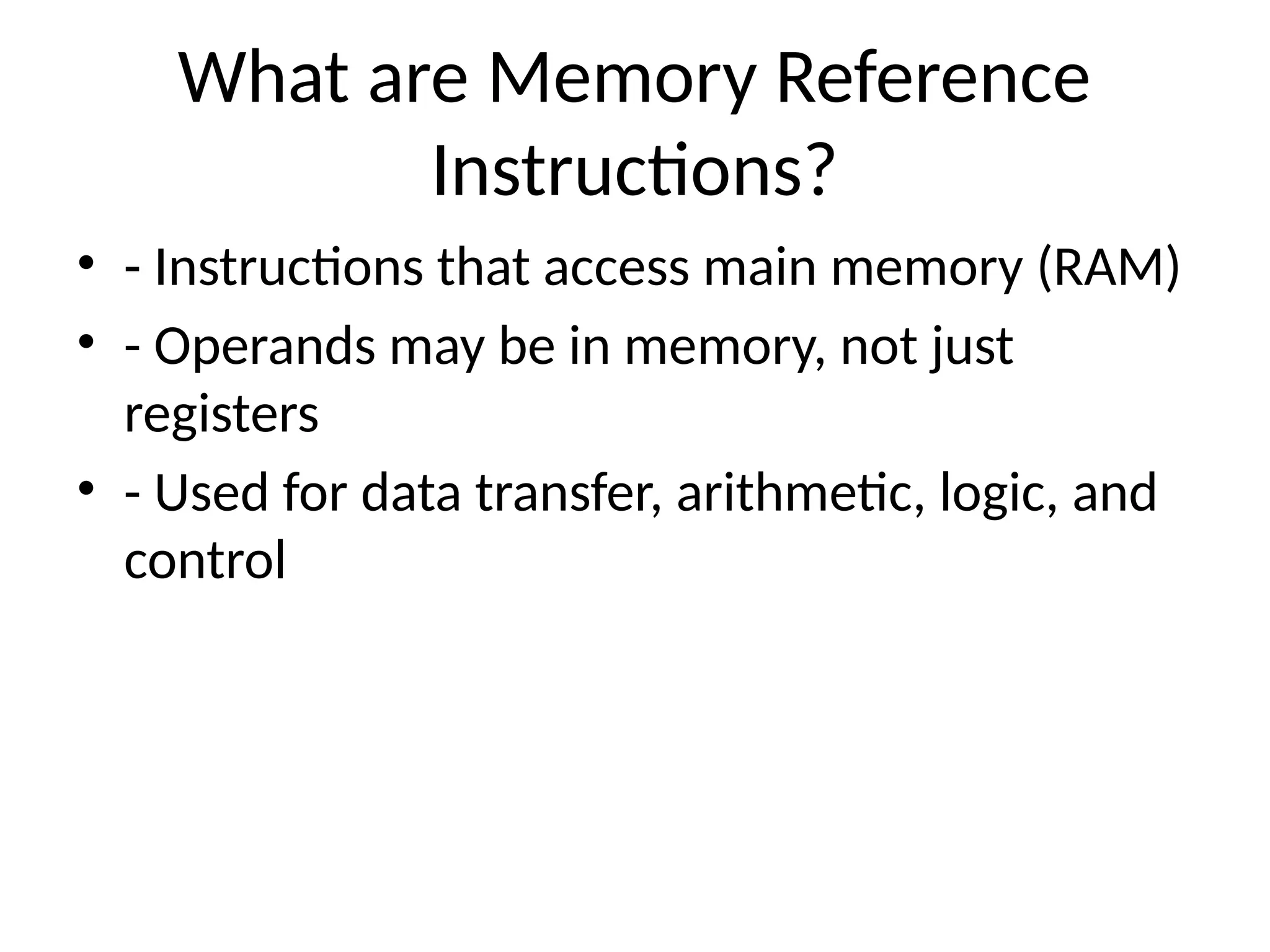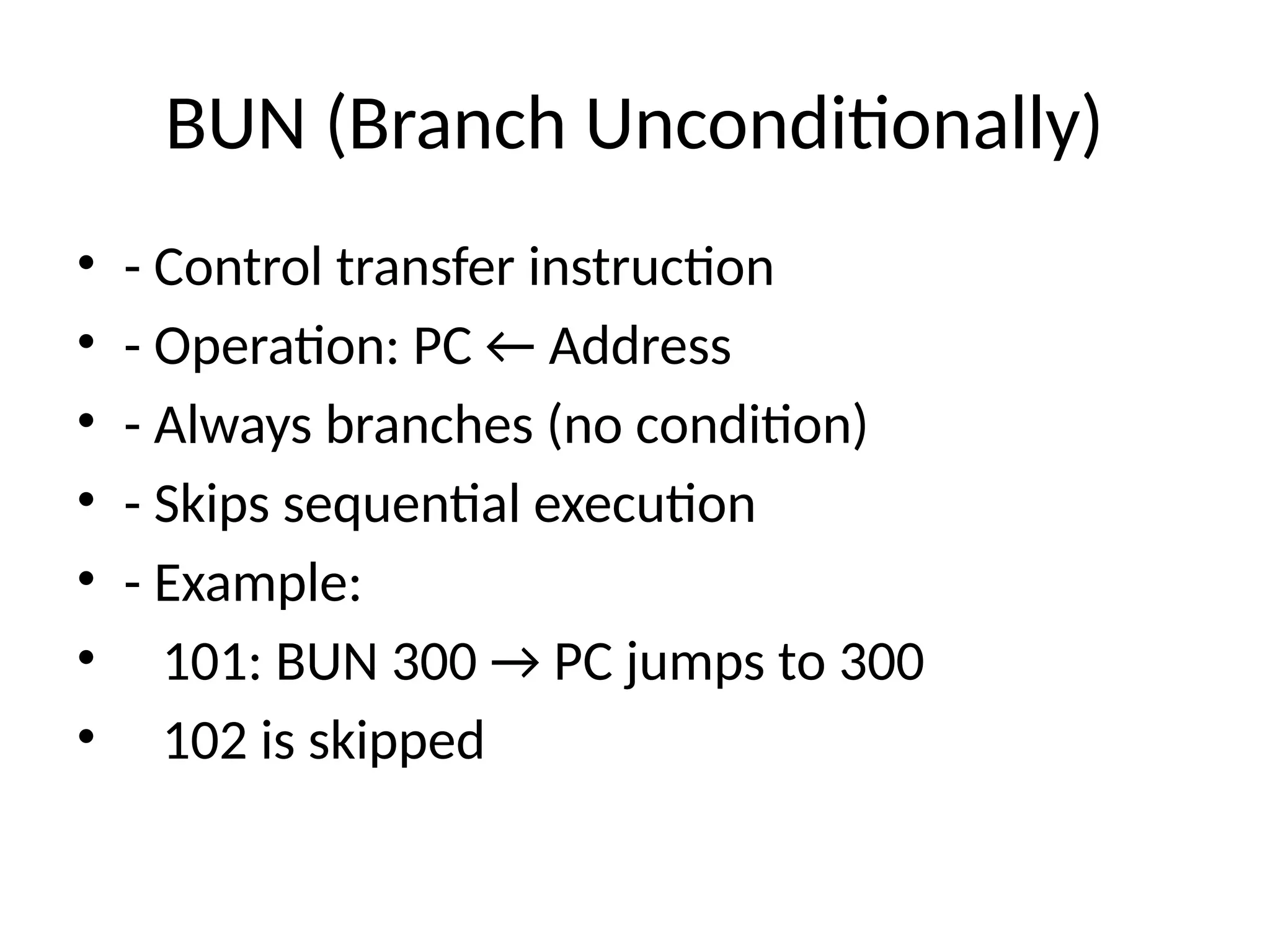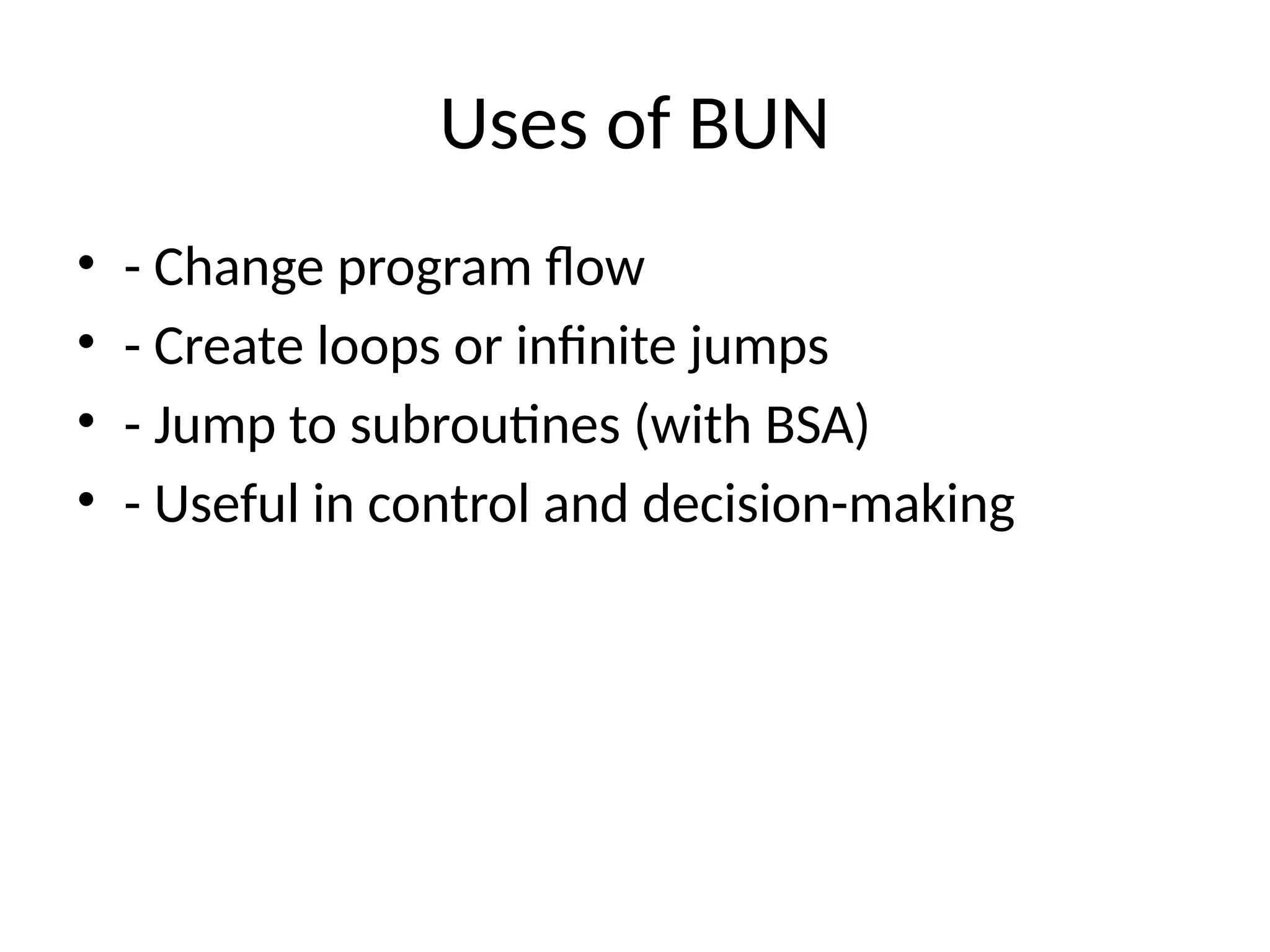Recommended Memory Reference Instructions
Memory Reference Instructions | Computer Science
Instruction Set Architecture (ISA)
Embedded Systems ARM Computer Architecture
ch 3_The CPU_modified.ppt of central processing unit
Instruction Set Architecture
Presentation2.pptx vtu computer organization and architectural
05 instruction set design and architecture
Lecture6.pdf computer architecture for computer science
Chapter 10 11 12 Instruction sets 10 11 12 Stallings.pptx
Chapter 10 11 Instruction sets Stallings.pptx
• To introduce the basic concepts of DC and AC circuits behavior
module 3 instruction set and control unit
unit2COA.pptxunit2COA.pptxunit2COA.pptxunit2COA.pptx
Lec3 instructions branch carl hamcher
Unit 1 basic structure of computers
ESD-unit 2-Hardware-Side-complete (1).ppt
timing_diagram_of_8085.pptx
basicfunctionalunit-190124043726555.pptx
Computer Organization Unit 4 Processor &Control Unit
microprocessor MICROPROCESSOR 8085 MICROPROCESSOR 8085
computer organisation and architecture Module 2.pptx
IML.pptxmachince learning power point presentation
Freshers Day - 2025 freahers day power point
More Related Content Memory Reference Instructions
Memory Reference Instructions | Computer Science
Instruction Set Architecture (ISA)
Embedded Systems ARM Computer Architecture
ch 3_The CPU_modified.ppt of central processing unit
Instruction Set Architecture
Similar to Memory_Reference_Instructions. Computer architecture Presentation2.pptx vtu computer organization and architectural
05 instruction set design and architecture
Lecture6.pdf computer architecture for computer science
Chapter 10 11 12 Instruction sets 10 11 12 Stallings.pptx
Chapter 10 11 Instruction sets Stallings.pptx
• To introduce the basic concepts of DC and AC circuits behavior
module 3 instruction set and control unit
unit2COA.pptxunit2COA.pptxunit2COA.pptxunit2COA.pptx
Lec3 instructions branch carl hamcher
Unit 1 basic structure of computers
ESD-unit 2-Hardware-Side-complete (1).ppt
timing_diagram_of_8085.pptx
basicfunctionalunit-190124043726555.pptx
Computer Organization Unit 4 Processor &Control Unit
microprocessor MICROPROCESSOR 8085 MICROPROCESSOR 8085
computer organisation and architecture Module 2.pptx
More from JvSuresh1 IML.pptxmachince learning power point presentation
Freshers Day - 2025 freahers day power point
Lec3 8086.ppt 8086 microprocessor micro processors
microprocessor8085pptcomplete-170518063501 (1).pptx
int cycle ppt instructions cycle computer
unit3 (1).ppt microprocessor 8086 microprocessor
AI UNIT-1.pptx artificial intelligence unit
8085 timing.pptx microprocessor 8085 timing
CAO Unit-1 computer organization architecture
Instruction timing diagram in micro processor
microprocessor8085pptcomplete-170518063501 (1).pptx
CAO Performance Measure and machine instrcutions
MOV Instruction Timimg diagram using opcode
Recently uploaded Presentation1jdhdhhhjjjdbbdnjenmmen.pptx
MS. LAPORE (QUIZ BOWL FILE 2025) . pdf
How to Set Up Default Header_Footer in Odoo 18.2
Karunadu Sambhrama 2025 - A Karnataka Quiz by Bengaluru Quiz Qatte
DepEd_ARAL_Program_Orientation FINAL COPY.pptx
how to write your research instrument.pdf
2025 Caribbean Examinations Council CSEC Merit List
Gastro retentive drug delivery system pradip
Layers of the Earth crust and Lithosphere.ppt
Plant Domestication | Evolution of Modern Agriculture
Political conditions of India during 6th cent BCE: Janpadas and Republics
Hunwick's Roman Roads and Ridge Roads, a Discussion Document
Nasopulmonary drug delivery system Pradip Sontakke
PTE Answer Short Questions_ 50+ Most Repeated Questions & Smart Tips to Score...
Projects_for_Ministries,_Departments_&_Agencies2123341679.pdf
Gene Pool in Crop Plants: Diversity, Classification, and Role in Plant Breedi...
Creating Motion Graphics and Videos with Generative AI
jkjkjkjkjkjkjkjfjeofu9 u93r u80 dhuybufy eiufcuetc i heiehf
Auto Autorefractometer/ppt/notes/pdf.pdf
Hudson Vitale "AI Essentials: From Tools to Strategies: A 2025 NISO Training ...
Memory_Reference_Instructions. Computer architecture 1. 2. What are Memory Reference Instructions? • - Instructions that access main memory (RAM) • - Operands may be in memory, not just registers • - Used for data transfer, arithmetic, logic, and control 3. General Instruction Format • [ Opcode | Address ] • - Opcode: Specifies the operation (e.g., LDA, STA, ADD) • - Address: Memory location of operand 4. Examples of Memory Reference Instructions • 1. LDA → Load Accumulator from memory • 2. STA → Store Accumulator into memory • 3. ADD → Add memory content to Accumulator • 4. SUB → Subtract memory content from Accumulator • 5. AND / OR → Logical operations with memory • 6. BUN → Branch Unconditionally 5. BUN (Branch Unconditionally) • - Control transfer instruction • - Operation: PC ← Address • - Always branches (no condition) • - Skips sequential execution • - Example: • 101: BUN 300 → PC jumps to 300 • 102 is skipped 6. Uses of BUN • - Change program flow • - Create loops or infinite jumps • - Jump to subroutines (with BSA) • - Useful in control and decision-making


![General Instruction Format • [ Opcode | Address ] • - Opcode: Specifies the operation (e.g., LDA, STA, ADD) • - Address: Memory location of operand](https://image.slidesharecdn.com/memoryreferenceinstructions-250902185438-bfb6bd50/75/Memory_Reference_Instructions-Computer-architecture-3-2048.jpg)





![General Instruction Format • [ Opcode | Address ] • - Opcode: Specifies the operation (e.g., LDA, STA, ADD) • - Address: Memory location of operand](https://image.slidesharecdn.com/memoryreferenceinstructions-250902185438-bfb6bd50/75/Memory_Reference_Instructions-Computer-architecture-3-2048.jpg)


